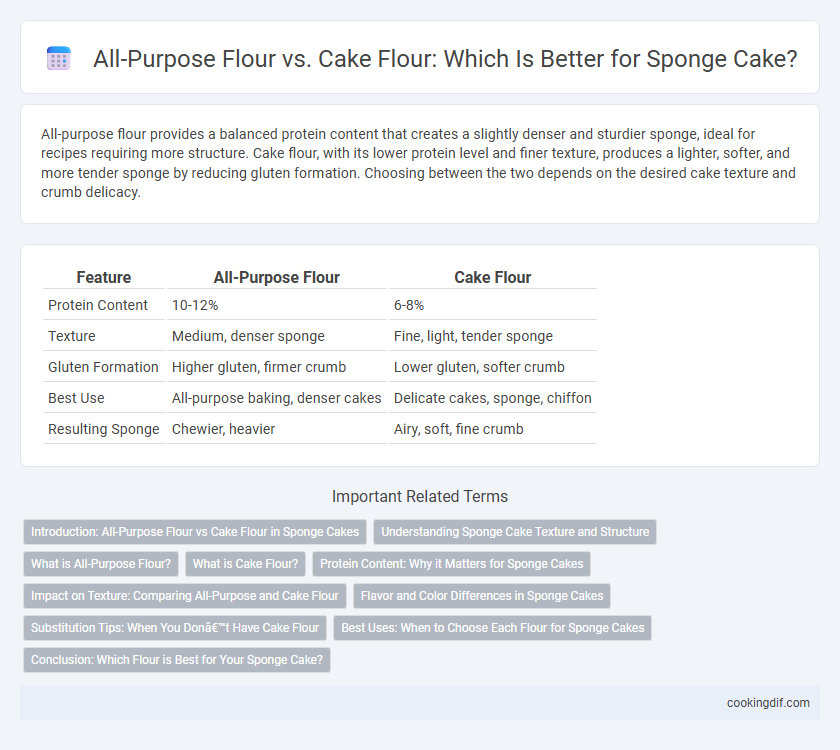All-purpose flour provides a balanced protein content that creates a slightly denser and sturdier sponge, ideal for recipes requiring more structure. Cake flour, with its lower protein level and finer texture, produces a lighter, softer, and more tender sponge by reducing gluten formation. Choosing between the two depends on the desired cake texture and crumb delicacy.
Table of Comparison
| Feature | All-Purpose Flour | Cake Flour |
|---|---|---|
| Protein Content | 10-12% | 6-8% |
| Texture | Medium, denser sponge | Fine, light, tender sponge |
| Gluten Formation | Higher gluten, firmer crumb | Lower gluten, softer crumb |
| Best Use | All-purpose baking, denser cakes | Delicate cakes, sponge, chiffon |
| Resulting Sponge | Chewier, heavier | Airy, soft, fine crumb |
Introduction: All-Purpose Flour vs Cake Flour in Sponge Cakes
All-purpose flour contains higher protein content, ranging from 10-12%, which provides more gluten development, resulting in denser and chewier sponge cakes. Cake flour has a lower protein content, around 7-9%, producing a finer, lighter, and softer crumb ideal for delicate sponge cakes. Choosing cake flour enhances tenderness and volume, critical for achieving the classic airy texture of sponge cakes.
Understanding Sponge Cake Texture and Structure
All-purpose flour contains higher protein content than cake flour, resulting in more gluten development, which makes sponge cakes denser and chewier. Cake flour's lower protein level produces a finer, more tender crumb with a lighter, airier texture ideal for delicate sponge cakes. Choosing cake flour enhances the absorbency and softness of the sponge, contributing to optimal rise and fragile crumb structure.
What is All-Purpose Flour?
All-purpose flour is a versatile wheat flour with a moderate protein content ranging from 10% to 12%, making it suitable for various baked goods including breads, cookies, and cakes. For sponge cakes, all-purpose flour provides structure but can result in a denser texture compared to cake flour due to its higher gluten-forming proteins. Its widespread availability and balanced composition make it a common choice for bakers seeking a reliable flour option when cake flour is not on hand.
What is Cake Flour?
Cake flour is a finely milled, low-protein flour usually containing about 7-9% protein, which results in a lighter, softer texture ideal for delicate sponge cakes. Its lower gluten content compared to all-purpose flour ensures a tender crumb and fine crumb structure, enhancing the cake's fluffiness and moisture retention. Often bleached to improve its baking qualities, cake flour is preferred for recipes where a light, airy sponge is desired.
Protein Content: Why it Matters for Sponge Cakes
All-purpose flour typically contains 10-12% protein, providing moderate gluten development that results in a denser, chewier sponge cake. Cake flour has a lower protein content, around 7-9%, which produces less gluten and yields a lighter, softer, and more tender crumb ideal for delicate sponge cakes. Choosing cake flour over all-purpose flour ensures a fine, airy texture by minimizing gluten formation and maintaining optimal moisture retention.
Impact on Texture: Comparing All-Purpose and Cake Flour
Cake flour contains lower protein content (7-8%) compared to all-purpose flour (10-12%), resulting in less gluten formation and a softer, lighter texture in sponge cakes. The fine, bleached nature of cake flour also improves moisture absorption and tenderness, creating a delicate crumb structure ideal for sponges. Using all-purpose flour often produces a denser, chewier sponge due to higher gluten content, making cake flour the preferred choice for a fluffy, airy texture.
Flavor and Color Differences in Sponge Cakes
Cake flour yields a lighter, fluffier sponge with a tender crumb and a subtly sweet flavor due to its lower protein content and finer texture. All-purpose flour produces a denser cake with a slightly coarser texture and a more pronounced wheat flavor that can affect the delicate taste of sponge cakes. The color difference is notable, as cake flour leads to a paler, almost white sponge, while all-purpose flour results in a slightly darker, off-white crumb.
Substitution Tips: When You Don’t Have Cake Flour
When you don't have cake flour for making a sponge cake, substitute all-purpose flour by removing 2 tablespoons of flour per cup and replacing it with 2 tablespoons of cornstarch to mimic cake flour's lower protein content. Sift the mixture thoroughly to ensure even distribution and a lighter texture. This adjustment helps achieve the tender crumb and soft structure essential for a perfect sponge cake.
Best Uses: When to Choose Each Flour for Sponge Cakes
Cake flour is ideal for sponge cakes when a light, tender crumb is desired due to its low protein content, which produces less gluten. All-purpose flour suits sponges that require more structure and density, offering versatility for slightly denser cakes or layered desserts. Choose cake flour for delicate, airy sponges and all-purpose flour for sturdier, more resilient sponge textures.
Conclusion: Which Flour is Best for Your Sponge Cake?
Cake flour is best for sponge cakes due to its lower protein content, resulting in a finer, softer crumb and lighter texture. All-purpose flour can be used but may produce a denser, chewier sponge because of higher gluten development. For achieving the traditional airy and tender sponge cake, cake flour remains the optimal choice.
All-purpose Flour vs Cake Flour for sponge Infographic

 cookingdif.com
cookingdif.com